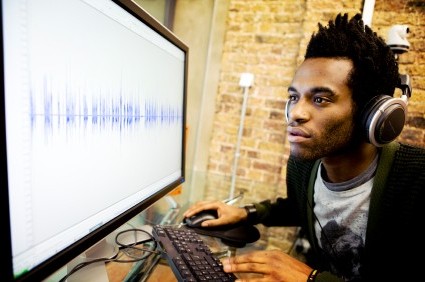You know already how easy it is to record audio into your computer with a microphone (for a reminder, see our article How to Use the PC Recording Studio You Didn’t Know You Already Had). But did you know you could also record whatever audio is already playing in Windows – on your sound card – also? It isn’t as obvious how to do this, but below is a good article that will show you step-by-step. It comes in handy if you want to record things like Skype conversations (just make sure you tell the other person first!), webinars, music from internet radio or YouTube, etc.
See the article here: http://www.pcadvisor.co.uk/how-to/windows/3400328/how-record-windows-audio-on-your-pc-or-laptop/
It focuses on Windows 7, but the concepts are the same for any version of Windows.
Setting Up a Home Recording Studio|Start Using Yours in The Next Hour
 Setting Up a Home Recording Studio – The Newbies Guide To Audio Recording Awesomeness is our 1st video-tutorial course, and will show you how to start a home studio in less than an hour and have you producing professional sounding audio from it. The cost for the studio? How about $5.00 (for a PC mic if you don’t already have one)? Once you’re ready to crank it up a notch or three, the 2nd in our Audio Recording Awesomeness series awaits – The Newbies Guide To Audio Recording Awesomeness 2: Pro Recording With Reaper. That course moves into the professional realm of audio recording using the incredible software, Reaper, and delving into move advanced topics like MIDI and virtual instruments, loops, and several time-saving voice-over production techniques like quickly slicing one file into many, saving each with it’s own file name, and rapidly creating multi-character dialogue projects.
Setting Up a Home Recording Studio – The Newbies Guide To Audio Recording Awesomeness is our 1st video-tutorial course, and will show you how to start a home studio in less than an hour and have you producing professional sounding audio from it. The cost for the studio? How about $5.00 (for a PC mic if you don’t already have one)? Once you’re ready to crank it up a notch or three, the 2nd in our Audio Recording Awesomeness series awaits – The Newbies Guide To Audio Recording Awesomeness 2: Pro Recording With Reaper. That course moves into the professional realm of audio recording using the incredible software, Reaper, and delving into move advanced topics like MIDI and virtual instruments, loops, and several time-saving voice-over production techniques like quickly slicing one file into many, saving each with it’s own file name, and rapidly creating multi-character dialogue projects.
This is awesome stuff. Enjoy!
Ken
ps-for more on home studio recording, check out this interesting article: http://www.stanford.edu/group/ccr/blog/2010/11/the_future_of_music_production.html
Zero Latency Recording With Reverb
I don’t record anything with effects in any way. It certainly is not a good idea to print effects as you record (recording a reverb along with your voice, for example). But some people like to hear reverb with their voice as they record, but just not have the reverb itself be recorded, if that makes sense. Well this is not that easy when recording with a computer because of a thing called latency – the delay between what you do and when the computer records it.
Here is an article that shows you how you can hear that great reverb on your voice as you record (but not printing the effect):
http://therecordingrevolution.com/2012/09/24/how-to-record-zero-latency-vocals-with-reverb/
EQ Basics – A Video Primer
Here is a quick, but very cool overview of equalization (EQ). The video (from the WinkSound YouTube Channel) shows you different kinds of EQ and goes over the parameters of each. It also goes over what controls are typically available (bandwidth – sometimes called “Q,” frequency, amplitude, etc.) on different types of EQ units or plugins.
By the way, there are built-in EQ tools in both Audacity and Reaper recording programs, and we show you how to use them in both of our courses in the Newbies Guide To Audio Recording Awesomeness series (TNGTARA 1 uses Audacity and TNGTARA2 uses Reaper).
And without further ado, here is the video:
Linear Phase and Minimum Phase Equalization
Did you know that not all equalization (EQ) is the same? BTW, if you need a reminder of what EQ is, see our article What is Equalization, Usually Called EQ? Anyway, yeah – usually we work with linear phase EQ. But there is also a thing called minimum-phase equalization. Here is a great article by Samuel O’Sullivan that will explain it all to you.
Read the full thing here: http://www.prosoundweb.com/article/in_the_studio_linear_phase_vs._minimum_phase_eq_includes_video